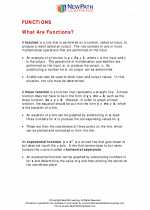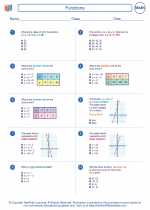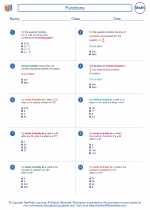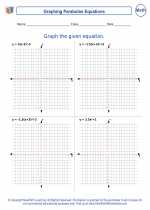Equation Study Guide
An equation is a mathematical statement that shows the equality of two expressions. It consists of two sides separated by an equals sign (=).
Types of Equations
There are different types of equations, including:
- Linear Equations: Equations of the form ax + b = c, where a, b, and c are constants and x is the variable.
- Quadratic Equations: Equations of the form ax^2 + bx + c = 0, where a, b, and c are constants and x is the variable.
- Exponential Equations: Equations involving exponential functions, such as 2^x = 16.
- Trigonometric Equations: Equations involving trigonometric functions, such as sin(x) = 0.5.
Solving Equations
To solve an equation, you aim to find the value of the variable that makes the equation true. This involves performing operations to isolate the variable on one side of the equation.
Steps to Solve an Equation
- Combine Like Terms: Combine similar terms on each side of the equation.
- Isolate the Variable: Use inverse operations (addition, subtraction, multiplication, division) to isolate the variable on one side of the equation.
- Check Your Solution: Substitute the value found for the variable back into the original equation to ensure it satisfies the equality.
Equation Properties
Some important properties of equations include:
- Reflexive Property: For any real number a, a = a.
- Symmetric Property: If a = b, then b = a.
- Transitive Property: If a = b and b = c, then a = c.
Applications of Equations
Equations are used in various real-life scenarios, such as calculating distances, solving for unknown quantities in science and engineering, and modeling physical phenomena.
.◂Math Worksheets and Study Guides Eighth Grade. Functions
Study Guide Functions
Functions  Worksheet/Answer key
Worksheet/Answer key Functions
Functions  Worksheet/Answer key
Worksheet/Answer key Functions
Functions  Worksheet/Answer key
Worksheet/Answer key Functions
Functions  Worksheet/Answer key
Worksheet/Answer key Parabolas
Parabolas  Worksheet/Answer key
Worksheet/Answer key Parabolas
Parabolas 

 Worksheet/Answer key
Worksheet/Answer key
 Worksheet/Answer key
Worksheet/Answer key
 Worksheet/Answer key
Worksheet/Answer key
 Worksheet/Answer key
Worksheet/Answer key
 Worksheet/Answer key
Worksheet/Answer key

The resources above cover the following skills:
Grade 8 Curriculum Focal Points (NCTM)
Algebra: Analyzing and representing linear functions and solving linear equations and systems of linear equations
Students use linear functions, linear equations, and systems of linear equations to represent, analyze, and solve a variety of problems. They recognize a proportion (y/x = k, or y = kx) as a special case of a linear equation of the form y = mx + b, understanding that the constant of proportionality (k) is the slope and the resulting graph is a line through the origin. Students understand that the slope (m) of a line is a constant rate of change, so if the input, or x-coordinate, changes by a specific amount, a, the output, or y-coordinate, changes by the amount ma. Students translate among verbal, tabular, graphical, and algebraic representations of functions (recognizing that tabular and graphical representations are usually only partial representations), and they describe how such aspects of a function as slope and y-intercept appear in different representations. Students solve systems of two linear equations in two variables and relate the systems to pairs of lines that intersect, are parallel, or are the same line, in the plane. Students use linear equations, systems of linear equations, linear functions, and their understanding of the slope of a line to analyze situations and solve problems.
Connections to the Grade 8 Focal Points (NCTM)
Algebra: Students encounter some nonlinear functions (such as the inverse proportions that they studied in grade 7 as well as basic quadratic and exponential functions) whose rates of change contrast with the constant rate of change of linear functions. They view arithmetic sequences, including those arising from patterns or problems, as linear functions whose inputs are counting numbers. They apply ideas about linear functions to solve problems involving rates such as motion at a constant speed.